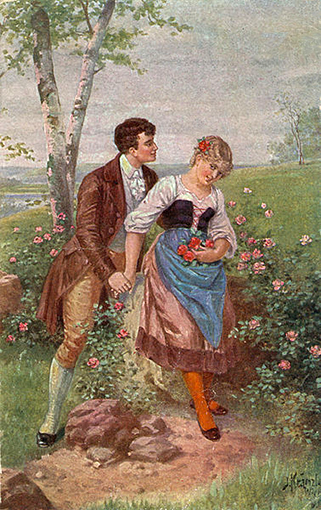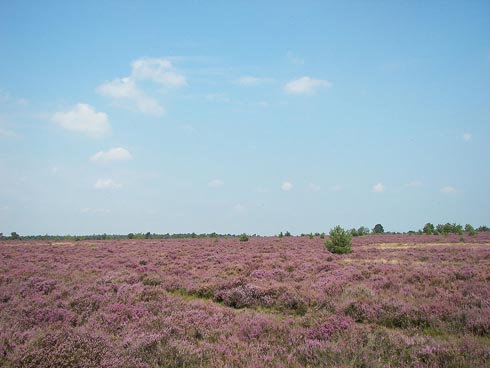Heidenröslein
"Heidenröslein" was written as a poem by Johann Wolfgang von Goethe. It was first published in 1799. Franz Schubert put the poem to music in 1815. Two other German composers also put it to music: Carl Friedrich Zelter and Heinrich Werner.
This song can be interpreted as a man being rejected by a woman (represented by the rose).

Heidenröslein
Little Rose on the Moor
Traditional Song
Traditional Song
(German)
(English)
Sah ein Knab' ein Röslein stehn,
Röslein auf der Heiden,
War so jung und morgenschön,
Lief er schnell, es nah zu sehn,
Sah's mit vielen Freuden.
Röslein Röslein Röslein rot,
Röslein auf der Heiden.
Knabe sprach; Ich breche dich,
Röslein auf der Heiden!
Röslein sprach; Ich stece dich,
Dass du ewig denkst an mich,
Und ich will's nicht leiden.
Röslein Röslein Röslein rot,
Röslein auf der Heiden.
Und der wilde Knabe brach
's Röslein auf der Heiden;
Röslein wehrte sich und stach,
Half ihm doch kein Weh und Ach,
Musst es eben leiden.
Röslein Röslein Röslein rot,
Röslein auf der Heiden.
A boy saw a little rose standing,
Little rose on the moor,
It was so young, and beautiful like the morning.
He quickly ran to see it up close,
Delightedly, he saw it,
Little rose, little rose, little red rose,
Little rose on the moor.
The boy said: "I'll pick you,
Little rose on the moor."
The little rose said: "I'll prick you,
So that you'll always remember me,
And I will not suffer."
Little rose, little rose, little red rose,
Little rose on the moor.
And the unruly boy picked
The little rose on the moor;
The little rose fought back and pricked,
But it was in vain,
It had to put up with it.
Little rose, little rose, little red rose,
Little rose on the moor.
Notes
1st Midi Tune: Schubert
2nd Midi Tune: Werner
There is a companion poem by Goethe, "Das Veilchen", in which the man is represented by a violet.

Comments
Sadao Mazuka wrote from Japan, "My wife took a tour of Europe with about 30 active women from Shizuoka-prefecture in 1995. I heard an interesting story about the final day of their 15 day trip...
They all took home-stay at the southern part of Germany. And all were invited to the local wedding party that happened at that time. At the final event of the party, they all sang 'Heidenröslein' in German. But the reaction of the audience at the party didn't quite make the grade. The German people didn't sing it. Why do you think?
The ladies sang the song to the Schubert tune (1st midi tune). They should have sung it to the Werner version (2nd midi tune)!
The German people at the party, didn't they know about the Schubert tune?
I am not sure, but I suppose they normally sing it to the Werner tune. Schubert was an Austrian you know!"


Thanks!
Thanks!
Thanks and Acknowledgements
Many thanks to Sadao Mazuka for sharing this song with us, for the commentary and the midis. Translation by Lisa Yannucci.
Painting of Poem: By Josef Kränzle (1874-1937) before 1937.
Photo of Moor: Wikipedia
























